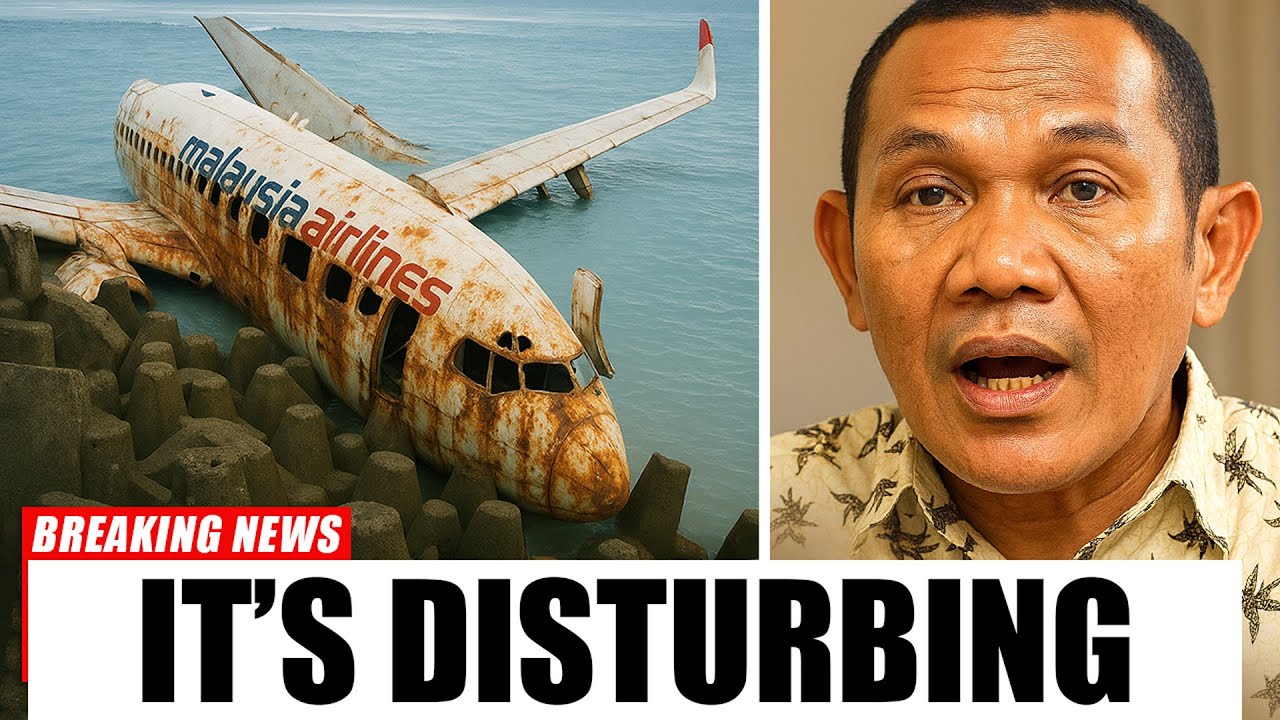😱 SHOCKING REVELATION: A local fisherman just broke his silence on MH370, unveiling a chilling truth that’s been hidden for over a decade! 🚨 What he saw that fateful night could unravel aviation’s greatest mystery—and it’s more disturbing than you can imagine. Dare to discover what’s been buried?
Click to uncover the full story:

On March 8, 2014, Malaysia Airlines Flight MH370, a Boeing 777 carrying 239 passengers and crew, vanished en route from Kuala Lumpur to Beijing, cementing its place as aviation’s greatest unsolved mystery. Despite extensive searches costing over $150 million and spanning 120,000 km² in the Southern Indian Ocean, the main wreckage remains elusive. In recent years, two fishermen—one from Indonesia and one from Australia—have come forward with startling claims, asserting they witnessed or encountered evidence of MH370’s fate. These accounts, described as “disturbing” by viral media, have reignited public fascination and skepticism. This article examines their stories, the scientific evidence, ongoing search efforts, and the broader implications of these claims, questioning whether they hold the key to closure or merely deepen the enigma.
The Fishermen’s Accounts
In January 2019, Rusli Khusmin, a 42-year-old Indonesian fisherman, made headlines at a press conference in Subang Jaya, Malaysia. He claimed that on the night of March 8, 2014, he and his crew saw MH370 crash into the Sumatra Sea, between Malaysia and Indonesia. Khusmin described a damaged aircraft emitting thick black smoke, moving erratically “like a broken kite” before plunging into the water with no audible impact. He recorded GPS coordinates and swore an oath of truth on the Koran, but admitted he delayed reporting for nearly five years, fearing disbelief. His account lacks corroboration from other witnesses or physical evidence, and the Sumatra Sea location contradicts radar and satellite data placing MH370’s final trajectory far south in the Indian Ocean.
In December 2023, Kit Olver, a 77-year-old retired Australian fisherman, shared a different story with the Sydney Morning Herald. Olver recounted that in September or October 2014, his deep-sea trawler, fishing 50 miles off South Australia’s coast, snagged a massive object he identified as a commercial airliner’s wing—too large for a private jet and too heavy to retrieve. His crewmate, George Currie, corroborated the account, describing the object as “incredibly heavy and awkward.” Olver reported the find to the Australian Maritime Safety Authority, which suggested it might be a lost shipping container, a claim he dismissed based on his 35 years of trawling experience. This location, in the Southern Ocean, is closer to the suspected crash zone but still distant from the 7th arc, where debris drift models focus.
The Scientific Consensus
Both fishermen’s claims face scrutiny against robust scientific evidence. Military radar tracked MH370 deviating west over the Malay Peninsula, past Penang, and into the Andaman Sea before turning south. Inmarsat satellite “handshakes” indicate the plane flew for seven hours, likely until fuel exhaustion, ending along the 7th arc, 1,800 km southwest of Perth, Australia. Debris drift analysis by the Commonwealth Scientific and Industrial Research Organisation (CSIRO) supports this, with confirmed MH370 fragments—like a flaperon on Réunion Island in 2015—washing up on Indian Ocean shores. The Sumatra Sea is too far north, and South Australia’s coast is inconsistent with drift patterns, which suggest westward currents. Ocean Infinity’s 2025 search, resumed in February and paused in April due to seasonal conditions, targets a 15,000 km² area near the 7th arc, with a $70 million “no find, no fee” contract. No credible evidence supports the fishermen’s locations, and experts like aviation analyst Geoffrey Thomas argue their accounts are likely misinterpretations of unrelated events.
The “Disturbing” Narrative
The “disturbing” label attached to these claims stems from their implications and media amplification. Khusmin’s description of a smoking, erratic plane suggests a catastrophic failure or sabotage, evoking images of panic aboard. Olver’s account of a massive wing implies a physical remnant overlooked by authorities, fueling conspiracy theories of a cover-up. Viral YouTube videos and articles, like one titled “World Stunned! Local Fisherman FINALLY Reveals The Truth About MH370,” exaggerate these stories, often without verifying details. On X, posts speculate about government suppression or deliberate misdirection, though no evidence supports these claims. The emotional weight of 239 lost lives, coupled with the lack of closure, makes such narratives compelling, even if scientifically dubious.
Theories Surrounding MH370
The fishermen’s accounts add to a tapestry of theories. The leading hypothesis, supported by a 2018 report and former Australian PM Tony Abbott, suggests pilot suicide by Captain Zaharie Ahmad Shah. Simulator data from his home showed a flight path mirroring MH370’s, ending in the Indian Ocean, though his family denies personal issues like a troubled marriage. Other theories include mechanical failure (e.g., a fire, as proposed by pilot Chris Goodfellow), hijacking, or cyberattack, though no distress signals or ransom demands emerged. Outlandish claims—like a US shootdown near Diego Garcia or a secret landing in Kazakhstan—lack evidence. The fishermen’s stories, while vivid, don’t align with radar, satellite, or debris data, reducing their plausibility.
The Role of Technology and Ongoing Efforts
Advanced technology continues to drive MH370 searches. AI models analyze Inmarsat pings, ocean currents, and Weak Signal Propagation Reporter (WSPR) data, with researcher Richard Godfrey proposing a crash site at 29.128°S. Hydroacoustic studies from Cardiff University explore underwater impact signals, while barnacle geochemistry on debris offers temperature-based clues. Ocean Infinity’s Armada 78 vessels, equipped with sonar and autonomous drones, represent the cutting edge, having located wrecks like the USS Nevada. The 2025 search, set to resume by December, leverages these tools, but the Southern Indian Ocean’s 6,000-meter depths and rugged terrain pose challenges. Even if found, black boxes may be unreadable after a decade underwater.
The Human Toll
The absence of answers devastates families. Over 150 Chinese passengers, alongside Malaysians, Australians, and others, were aboard, leaving relatives like Jiang Hui and Grace Nathan in prolonged grief. Protests in Beijing in 2024 highlighted frustration with Malaysia’s opaque updates. The fishermen’s claims, while offering hope, also risk false expectations, as seen in past unverified reports. Jaquita Gonzales, whose husband was the flight supervisor, called the 2025 search “bittersweet,” reflecting the emotional complexity of renewed efforts.
Challenges and Future Prospects
Verifying the fishermen’s claims is nearly impossible without physical evidence. Khusmin’s delayed report and Olver’s inability to retrieve the wing weaken their credibility. The Southern Indian Ocean’s vastness, combined with public skepticism from years of failed searches, complicates progress. Yet, advancements in AI, robotics, and oceanography offer hope. If MH370 is found, it could mandate better aircraft tracking, as recommended by the 2018 ATSB report, preventing future tragedies.
Conclusion
The fishermen’s claims, while gripping, remain outliers against a mountain of data pointing to the Southern Indian Ocean. Their “disturbing” nature lies in their emotional pull, not their scientific weight. As Ocean Infinity’s search continues, the truth about MH370 may be closer than ever, but for now, these stories remind us of the mystery’s enduring hold on our collective imagination. Solving it would bring closure to families and lessons for aviation, but until then, we navigate a sea of speculation with cautious hope.





